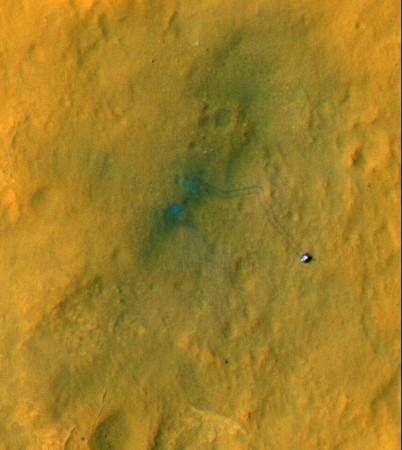
About a month after landing, NASA's Curiosity rover is making its mark on the surface of the red planet and is so big that it can be seen from space.
The Curiosity which landed on the surface of Mars on Aug 5 has driven 358 feet (109 metres), more than a football field's length, from its landing site named Bradbury Landing.
The drives have brought the spaceship about one-fourth of the way from the Bradbury Landing to a site which is chosen as the mission's first major science destination, Glenelg, NASA said.
The tire tracks from the first drive were captured by the High-Resolution Imaging Science Experiment (HiRISE) camera on NASA's Mars Reconnaissance Orbiter. The Curiosity can be seen where the track ended.
"We've been on the surface of Mars for about a month and Curiosity continues to surprise us with how well she's doing with everything we've asked off her," Mike Watkins, a mission systems manager at NASA's Jet Propulsion Laboratory (JPL), said according to CBS News.
"Now that [Curiosity has] moved, we've reached a point where we want to do a more detailed check of the arm and the tools on it," Watkins added.
When the pictures showed the tracks "there was much high-fiving," said mission manager Michael Watkins, according to Associated Press. Watkins also said that engineers were excited by the idea that "we left tracks on Mars that we can see from orbit," because it gave them a visible sense of accomplishment.
After driving 358 feet, the rover won't be travelling for about a week so that scientists can run detailed tests on the seven-foot (2.1-metre) robotic arm of Curiosity and the tools it manipulates.
"We will be putting the arm through a range of motions and placing it at important 'teach points' that were established during Earth testing, such as the positions for putting sample material into the inlet ports for analytical instruments," said Daniel Limonadi of NASA's Jet Propulsion Laboratory in Pasadena, California, lead systems engineer for Curiosity's surface sampling and science system.
"These activities are important to get a better understanding for how the arm functions after the long cruise to Mars and in the different temperature and gravity of Mars, compared to earlier testing on Earth," he added.
















